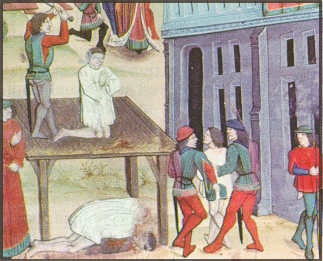

Beheading
Lunette is accused of treason. The usual punishment for treason (that is, acting or speaking against the King or Queen) was beheading if you were a noble, or hanging, drawing and quartering if you were an ordinary person. For murder, arson or robbery, men were hanged but women were burnt at the stake. Later in the Middle Ages (in the 14th Century), burning at the stake became the most common method of putting to death those accused of witchcraft or heresy (which at this time meant believing or teaching religious ideas other than those of the Catholic Church).

Burning at the Stake
A thief might be branded using a red-hot iron, and would carry the mark the mark for rest of his or her life. Other punishments were meant to shame the offenders, such as sitting in the stocks like the monk and the nun below

or being paraded through the streets in a cart.

A disgraced knight being driven through the streets in a cart
If an accused person did not turn up for a court case, they could be declared an outlaw. Their goods and property then belonged to the King and they had to leave their home and live as an outcast. Since this was a very common punishment, outlaws often joined together in bands. The most famous outlaw of all is Robin Hood